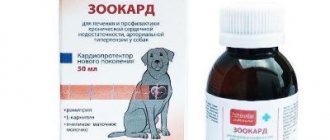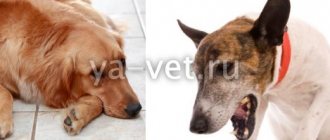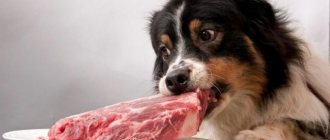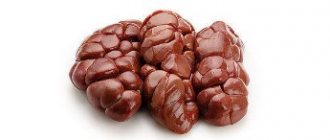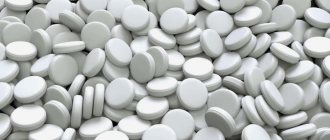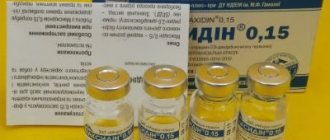A thoughtful and well-designed diet has a direct impact on the health of your four-legged pet. From the question: is it possible to feed dogs bones? Some are horrified because they believe that this is harmful to the animal, while others, on the contrary, are sure that the pet’s menu should not do without them.
What is the right thing to do if it is not clear whether it is possible to feed a dog beef bones, and what benefit or harm they will bring to the pet?
Is it possible to feed?
A dog's natural diet should include solid food. You can give her bones, but you need to do it very carefully and correctly.
Beef bones are allowed to be offered to dogs. It is best if these are large heads of the hip joints. Wait until the animal eats the cartilage tissue and meat, then immediately take the moslak from it. Spongy ones can be used as raw materials for broth, or as a toy.
Be sure to check at what age the animal whose bones you plan to feed your dog was killed. If they are young, then they can be fed to your pet without fear.
Because the older the animal was, the tougher its spongy substances become, which can break during eating and harm the dog.
Benefit
The benefit is that calcium, minerals, chondroitin and collagen enter the body along with them.
- Thanks to them, the chewing muscles are trained, but only if you give them no more than two or three times a week. Daily use leads to unnecessary stress.
- If you add the product to your diet in reasonable quantities, your teeth will not be at risk of developing tartar and plaque.
- Spongy substance, bone marrow, which is part of the bones, bring great benefits to the dog’s body, filling it with saturated and unsaturated fats.
- Nervousness is reduced in those pets who sometimes have the opportunity to chew bones, unlike those who are deprived of this pleasure.
Harm
Unfortunately, bones are not only harmful, but also endanger the health and life of your four-legged pet.
- They cause dogs' teeth to wear down and sometimes even break. Bad teeth deprive dogs of the opportunity to eat properly, which also leads to various diseases, but in the gastrointestinal tract.
- The mucous membrane of the intestines, stomach and esophagus will be damaged by fragments of crushed bones.
- Very often they get stuck in the throat. The owner cannot always pull it out on his own, without the intervention of a doctor.
- One common problem is intestinal impaction. In this case, too, there is no way to do without surgical intervention.
Useful tips
If after giving birth the bitch refuses to eat, there is no need to sound the alarm, this is a normal situation. But receiving adequate nutrition is necessary for mother and babies; in this case, it is advisable not only to offer food, but to feed the dog every 4-6 hours.
Proper nutrition is the key to a long healthy life for an animal. The daily menu is developed depending on the age of the Labrador and its individual characteristics. The right choice, calculation of the portion of dry food and the required amount of natural food will provide the dog with energy and vitamins. The pet should not receive leftovers from the owner’s table, sweets or foods prohibited for the breed.
Many dogs love watermelon. The delicacy is not considered dangerous, but it should be offered in limited quantities. It is not recommended to eat the green peel, only the pitted pulp. Do not forget about the diuretic properties of the berry and the need for additional walking of the dog.
Proper nutrition is the key to a long healthy life for an animal. The daily menu is developed depending on the age of the Labrador and its individual characteristics. The right choice, calculation of the portion of dry food and the required amount of natural food will provide the dog with energy and vitamins. The pet should not receive leftovers from the owner’s table, sweets or foods prohibited for the breed.
Proper nutrition is the key to a long healthy life for an animal. The daily menu is developed depending on the age of the Labrador and its individual characteristics. The right choice, calculation of the portion of dry food and the required amount of natural food will provide the dog with energy and vitamins. The pet should not receive leftovers from the owner’s table, sweets or foods prohibited for the breed.
Who can't?
Dogs that eat commercial food should not be given bones. The acidity in their stomachs is altered so they will not be able to digest, which usually results in vomiting. The health and life of the animal is in danger in this case.
If your pet eats a mixed diet and his diet alternates between dry food and canned food and meat, then you should not give him bones either.
For pets who suffer from diseases of the gastrointestinal tract and take the drug omez, this type of product in the diet is contraindicated.
Pregnant females fed raw foods should not be given bones during the last weeks of pregnancy.
During the period when mothers begin to feed their puppies, bones should be completely excluded from their diet.
Basic rules for feeding Labradors
This breed of large dogs has a number of physiological characteristics. Labradors are prone to gaining excess weight and allergic reactions to various foods. Often these pets have increased sensitivity of digestion, heart and kidney problems. Owners may encounter all these problems if they feed their dog food from their table or choose an unsuitable diet.
Labradors like natural food, but it is very difficult to accurately select products in the right proportions, so experienced owners prefer ready-made food. food for Labradors has a proven composition, has been tested in laboratories, does not contain products that cause allergies and supplements the pet’s menu with essential vitamins and microelements.
What to do if you eat it?
Asphyxia, which often happens to dogs from eating bones, is very life-threatening. When a bone gets stuck in the teeth, the dog begins to drool profusely. Pets often choked on their own saliva.
It is very important at such a moment that the owner is able to notice in time that the dog has become ill and pull out the bone. If the moment is missed, then there is a high probability that the dog will die from suffocation.
Vomit
If your four-legged friend starts vomiting, take him to the veterinary clinic immediately. This reaction of the body indicates that most likely a large piece is stuck in the stomach and will not pass. Frequent vomiting dehydrates the animal's body. Only surgery in this case can save your pet.
Diarrhea with blood
Dogs that are fed bones too often have a clogged large intestine. This leads to pain and bleeding during bowel movements. If you notice such an illness in your dog, you should urgently show him to a veterinarian.
Utensils for food
All dishes for the dog should have smooth edges so as not to cut the tongue. Buy stainless steel bowls. Mount them on a bracket that you can purchase at a pet store. This tripod allows you to raise the bowl to the level of the dog’s elbow joints. This allows your Labrador to develop good posture.
15 minutes after eating, remove the bowl and wash it. This will teach the dog to routine and discipline.
For puppies
After two months from the moment of birth, puppies are allowed to pamper very rarely with a tasty bone.
Reference! In order to avoid many serious problems, do not leave your baby alone with a bone. Make sure he doesn't start gnawing and swallowing it.
A puppy can only be given bones in the form of cartilaginous veal ribs. With their milk teeth they gnaw out a spongy substance that is useful to them, and eat cartilage and tendons.
If you decide to give your baby beef brisket, it should be so large that the puppy cannot swallow it.
The bone must be intact and without chips. It is prohibited to give it naked, without any leftover meat, to children.
The product must be fresh and only be eaten raw by the puppy.
Prohibited Products
A list of products that can not only harm your pet's health, but also lead to death.
- pork, thick pieces of skin;
- hollow tubular bones;
- raw, river and unpeeled fish;
- raw unprocessed meat;
- smoked and fried foods;
- salt, sugar, sweets, chocolate;
- legumes (peas, beans, lentils);
- avocado, grapes, raisins, currants;
- plums, peaches, persimmons;
- potatoes, broccoli;
- sorrel, rhubarb, parsley (for pregnant bitches);
- onions, garlic (in large quantities);
- nuts (nutmeg, walnuts, hazelnuts, pistachios, macadamia);
- semolina, pearl barley and corn cereals, millet;
- pasta and flour products.
In addition to the above products, prohibited products include cow's milk (for adults), alcohol, hops and various spices.
What can be replaced
Pure milk is replaced with dairy products, which also contain calcium and other necessary elements, and are also easier to digest.
The alternatives are:
- kefir;
- cottage cheese;
- cheese;
- yogurt;
- sour cream;
- serum.
Kefir is recommended by experts for regular consumption, it is well absorbed, useful for the digestive process, it is recommended to be given to puppies and adults (especially overweight ones), however, not every dog will like the taste of a fermented milk drink. To prevent the intestines from being weakened by fat content, it is better to choose a low-fat product.
https://dog-care.ru/zdorove/pitanie/mozhno-li-davat-labradoru-moloko.html
Cottage cheese is easily digestible, can replace one full feeding for a puppy, it is included in the daily nutrition of babies, and is given to adult dogs twice a week. If there is a lack of calcium, you can pamper your pet with cottage cheese every day without disturbing the balance of the entire diet. An excess of this element leads to pathologies of the musculoskeletal system, skin, kidneys, and stomach. It is important to alternate calcium-containing products so as not to cause excess substance in the blood.
Cheese is often used as a reward for a pet during training. Choose a cheese variety without dyes, aromatic seasonings, mold; smoked, salted, processed types are not allowed in food. The norm is 70 grams per day for large breeds, 30 grams. – for small individuals. You should be careful with the cheese delicacy; your dog’s food preferences may change, and he will become picky about food.
Yogurt has a universal property, copes with diarrhea and constipation, has beneficial bacteria that promote normal digestion, its consumption reduces gas formation, helps eliminate toxins and waste. For preventive purposes, the dog is offered a couple of small spoons with other food; consumption is useful during illness and during the rehabilitation period, helping to protect and restore weakened health. Due to the presence of sugar, yogurt treats should not be overused.
Sour cream has a high fat content, if the dog tolerates it normally, then it is mixed with cottage cheese. For puppies, sour cream is included in the menu, not as an independent food, but as an additive - a few spoons per week is enough. The main thing is to observe moderation; fatty foods lead to increased cholesterol and abnormal functioning of the pancreas.
Whey is a lactoproduct consisting of water with a small proportion of fat; it is recommended to cook porridge with it; in its pure form it acts as a laxative and is given to dogs suffering from constipation.
An animal may develop an individual intolerance to any food; it is important to monitor the first test for response.
Ready-made food for large pets
Industrial food has a lot of advantages, which is why many breeders prefer dry food. You should not take cheap complexes, as they may contain dyes and flavors.
It is best to select super-premium or premium formulations.
How much and how often to feed directly depends on the age of the pet, as well as its health. But most often, owners use the instructions on the packaging.
Important! Veterinarians prohibit mixing natural food and ready-made formulations, this is harmful to the health of the animal. It is enough for an adult dog to give food twice a day, for puppies more often - 5-6 times a day.
Feed comparison
Industrial feeds are presented in a huge range. Experts recommend the following brands:
- Acana Grass-Fed Lamb is an excellent hypoallergenic holistic product that contains nutritional components in the form of lamb and vegetables.
- Advance Labrador Adult is an excellent complex that includes foods that are healthy for the breed: chicken, various grains. In addition, the composition contains biological additives to strengthen teeth, joints, as well as good heart function.
- Royal Canin Labrador Retriver Adult is a complex designed specifically for Labradors. The food consists of poultry, rice and other grain products.
Note! A Labrador will refuse food if it is spoiled or not at the proper temperature.
Mixed feeding
Mixed feeding is the alternation of natural food and prepared (industrial) food. In this case, reception should also be carried out in the morning and evening. But it is worth considering that they cannot be served at the same time, as this may have a bad effect on digestion.
Allergy
Animals react differently to similar stimuli. Milk protein intolerance is a food allergy and can be expressed by the following symptoms:
- swelling;
- eye, nasal, ear discharge;
- skin rash, redness, peeling; crust formation;
- itching;
- unpleasant odor;
- stool disorder.
If allergic symptoms occur, it is necessary to exclude the allergen from the diet. Failure to stop the alarming symptoms leads to a mandatory visit to the veterinarian; you cannot self-treat.
How to change the power plan
The transition from one power scheme to another should be smooth and gradual. During the shift, you should observe your pet and its reactions. Replacing natural food with dry food lasts an average of a week, but the reverse option takes longer, usually taking about 15-20 days.
It is best to feed the usual food in the morning, and treat it with a new one in the evening, moreover, increasing the dosage of the latter every day.
Both natural food and dry food are suitable for Labradors; the type of food is selected individually
Criteria for selecting a chewing bone
A loving owner will reward his furry friend with treats from the pet store. But how to choose the right bone for your dog?
- Taste. Manufacturers are ready to offer four-legged pets a wide range that will satisfy the desires of any gourmet dog. In order to understand what exactly he likes, you need to buy several different products and observe the reaction.
- Size. Large dogs often refuse large treats. They like to eat the middle bone.
- Texture. Some individuals like the product softer, others prefer it harder. You can understand which bone the animal will like by tasting several pieces.
Choosing the right store-bought treat is not an easy task. Dogs, like people, have different food preferences. But a rich assortment of popular delicacies will help the owner choose the right option.
Sample menu for the day
Daily consumption of natural feed is calculated based on the weight of the animal. For example, for an adult pet, 20 grams are required per 1 kg of body weight. meat products, 5-6 gr. ready-made cereals. Every day the dog should receive an amount of food corresponding to 2-3% of its own weight.
For example, a Labrador weighing 32 kg per day should receive 960 grams of natural food.
Morning:
- boiled offal (stomachs, heart) – 300 g;
- boiled vegetables – 60 g;
- buckwheat – 100 g;
- 1⁄2 tsp linseed oil;
- vitamins.
Evening:
- boiled or raw beef – 340 g;
- buckwheat – 100 g;
- boiled vegetables – 60 g;
- fermented baked milk or kefir 1-2.5% – 6 tbsp;
- 1 chicken egg yolk;
- vitamins.
In between feedings, you should not feed your Labrador with table scraps; you can give some berries or unsweetened fruits (video author Rita Kochetova).
What's the harm?
After the dog grows up and weans from the female mother, the enzyme that promotes the digestibility of milk stops being produced.
Possible complications:
- indigestion (diarrhea, vomiting, painful spasms, increased gas formation);
- allergic symptoms (swelling, itching, redness of the skin, peeling, hair loss, lacrimation, discharge from the nose and ears);
- excessive load on the liver;
- excess calcium and associated pathologies.
Dogs react differently, some drink milk throughout their lives without negative consequences. If the dog himself refuses to consume milk, there is no need to force him.
Products prohibited for dogs can cause significant harm to health, such as:
- fermented milk drinks tan, ayran (contain salt);
- condensed milk and ice cream (contain sugar);
- soy product analogue (soy is contraindicated).
The owner must properly organize the main dog diet and acceptable treats, monitor the well-being of the ward, and immediately contact a veterinarian if there are alarming signs.

